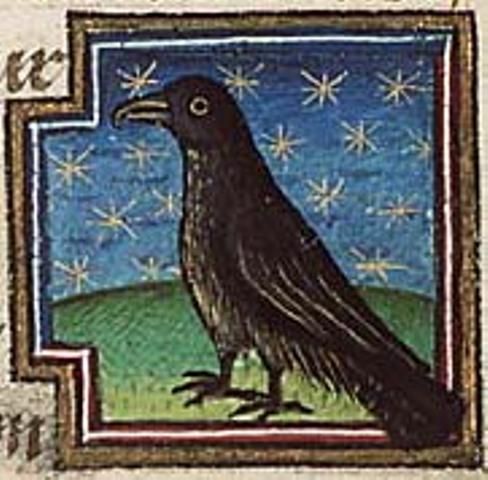















Coligny Calendar
The Coligny Calendar is a series of bronze tablets dating to the first century BCE; it is a record of the Gaulic (and thus Celtic) year, though it shows some Roman influence, as Roman numerals are used. However, the names of the month are given in Gaulish, and the year is often thought to begin in November, keeping with what we know of the Celtic year.
There is some debate as to whether the year begins in November 1, May 1, or even December 21 or June 21 (approximately, for the solstices). The argument for November 1st is that Samonios is obviously similar to the Irish Samhain, falling on November 1. That there is a festival on the 17th of Samonios called the TRINVX SAMO SINDIV--"the three nights of Samonios today", also recalls the three days associated with the modern Samhain--Halloween, All Saints' Day, and All Souls' Day. This could, of course, all be a coincidence. The argument for May 1st is that samonios is derived from samon, "summer." As May 1st marks the beginning of the summer half of the year in traditional Celtic lore, Samonios could easily be May 1st.
The calendar is both a lunar and solar calendar, which causes some problem with drifting; Garet Olmsted believes this accounts for Pliny's remark that the Gauls began their month on the sixth day of the moon, and not the first. By Olmsted's estimation (not shared by all academics), the calendar system was 1000 years old by the time it was inscribed at Coligny. If so, it likely predates the Celts (but then, so do other timekeepers, like Stonehenge). The calendar uses a mathematical arrangement to keep a normal 12 month calendar in sync with the moon by adding an extra month every 2 1/2 years in a a 25-year cycle.
Latin Gaulish Etymology Designation Length
November/May Samonios Summer ? MAT 30
December/June Dumannios Dark ? ANM 29
January/July Riuros Frost ? MAT 30
February/August Anagantios ANM 29
March/September Ogronios MAT 30
April/October Cutios Rain ? MAT 30
May/November Giamonios Winter ? ANM 29
June/December Simivisonnos Semi-Spring? MAT 30
July/January Equos Horse? ANM 29
August/February Elembivios ANM 29
September/March Edrinios Heat? MAT 30
October/April Cantlos Song? ANM 29
Ciallos (intercalculatory month) MAT 30
Alternately, the Olmsted Hypothesis:
Late June/Late December Samonios Summer
Late July/Late January Dumannios Dark
Late August/Late February Riuros Frost
Late September/Late March Anagantios
Late October/Late April Ogronios
Late November/Late May Cutios Rain?
Late December/Late June Giamonios Winter?
Late January/Late July Simivisonnos Semi-Spring?
Late February/Late August Equos Horses?
Late March/Late September Elembivios
Late April/Late October Edrinos Heat?
Late May/Late November Cantlos Song?
Given what the names might mean, the problem is finding a starting date that makes sense. "Dumannios" makes little sense for June-August, but might make sense for December-February, as would Riuros for January-March but not July-September.
The second problem is that there is no hard evidence that the Celts celebrated the solstices and equinoxes. They may have, but it's still unknown. Current scholarship says they did not, and so there is less reason to date the Coligny Calendar to starting on either solstice than for May 1st/November 1st. That does not mean the calendar does not begin on a solstice, only that there is no hard evidence yet to support this.1
Now, according to The Gallic Wars: "All the Gauls assert that they are descended from the god Dis, and say that this tradition has been handed down by the Druids. For that reason they compute the divisions of every season, not by the number of days, but of nights; they keep birthdays and the beginnings of months and years in such an order that the day follows the night."
And, in reading Pliny's statements on the Druids supposed custom of cutting the mistletoe on the sixth day of the moon, it has been assumed that the month began on the new moon, like the Jewish calendar. Actually, it has a lot of similarities to the Jewish calendar, which leads to an interesting question--did the Celts have contact with the Jews before they migrated west, or is this simply a not-uncommon human practice?
According to Ray White, "the era of the New Coligny Calendar (NCC) {began} on October 8th, 1999. This date was chosen because this date corresponds with a new moon on the date of the beginning of European winter. (when the sun is at 15Deg Scorpio)" which is also the day that the megalith at Tara marks the beginning of winter--the day the sun is at 15º Scorpio.
NOTES
1. What a strange irony it would be if the Celtic year--even if only for the Gauls--began at the winter solstice, just as in Robert Graves' Pseudo-Celtic tree calendar.
SOURCES
Jean Markale: The Pagan Mysteries of Halloween
Ray White's Coligny Calendar page: http://technovate.org/web/coligny.htm

Back to "C" | Back to JCE
Home
Mary Jones © 2004